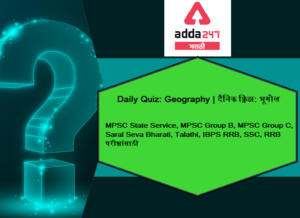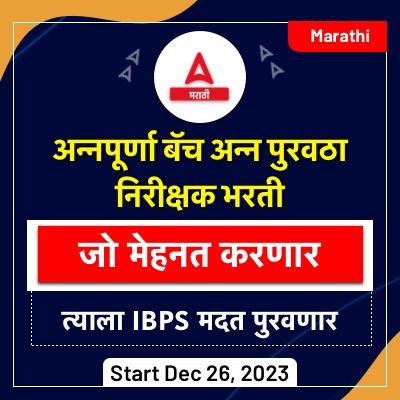
भूगोल दैनिक क्विझ मराठीमध्ये: 18 मे 2021
महाराष्ट्र राज्य लोकसेवा आयोग दरवर्षी वेगवेगळ्या परीक्षे मार्फत हजारो विद्यार्थ्यांची भरती करून घेते MPSC State Service, MPSC Group B, MPSC Group C, Saral Seva Bharati, Talathi, IBPS RRB, SSC, RRB अशा अनेक परीक्षांमार्फत हजारो जागांची भरती दरवर्षी निघते ज्यात लाखो इच्छुक हजार किंवा त्याहूनही कमी जागांसाठी अर्ज करतात. आपण एमपीएससी आणि इतर परीक्षाची तयारी करत असाल तर आपल्याला क्विझ देण्याचे महत्त्व माहित असलेच पाहिजे. बर्याच विद्यार्थ्यांना अभ्यासाचे पुरेसे तास दिले जात असतानाही त्यांना या परीक्षांची पूर्तताही करता आली नाही कारण ते त्यांचे पुनरीक्षण वेळेवर पूर्ण करू शकत नाहीत आणि संशोधन करण्याचा उत्तम मार्ग म्हणजे त्या संबंधित विषयाची किंवा विषयाची क्विझ देणे कारण आपण या मार्गाने कव्हर करू शकता कमी वेळात जास्तीत जास्त विषय. आम्हाला Add 247 मराठी येथे चांगल्या अभ्यास सामग्रीचे मूल्य समजले आहे आणि म्हणूनच आम्ही सर्व विषयांसाठी आपल्याला क्विझ प्रदान करीत आहोत. दैनिक क्विझ देऊन तुम्ही तुमच्या तयारीची पातळी तपासू शकता.
सर्व स्पर्धात्मक विषयांमध्ये भूगोलाचाही तेव्हडाच महत्वाचा वाटा आहे. तर चला भूगोल बद्दल तुमची तयारी तपासण्यासाठी खालील 18 मे 2021 ची भूगोल ची दैनिक क्विझ पहा.
Q1.भूमध्य शेतीच्या संदर्भात खालील विधानांचा विचार करा?
1. केवळ भूमध्य समुद्राच्या सभोवतालच्या प्रदेशांमध्ये याचा अभ्यास केला जातो.
2. भूमध्य प्रदेशाचे तापमान असे आहे की केवळ लिंबूवर्गीय फळेच वाढू शकतात.
वर दिलेली कोणती विधाने बरोबर आहेत?
(a) फक्त 1
(b) फक्त 2
(c) दोन्ही 1 आणि 2
(d) 1 किंवा 2 देखील नाही
Q2.सघन शेतीविषयक शेतीच्या संदर्भात खालील विधानांचा विचार करा
1. या प्रकारची शेती मोठ्या प्रमाणात मॉन्सून आशिया खंडात मोठ्या प्रमाणात आढळते.
2. या प्रकारच्या शेतीची वैशिष्ट्ये मदत वैशिष्ट्यांनुसार विशिष्ट प्रदेशात केंद्रित असलेल्या एका प्रकारच्या पिकाच्या वर्चस्वामुळे दर्शविली जातात
वर दिलेली कोणती विधाने बरोबर आहेत?
(a) फक्त 1
(b) फक्त 2
(c) दोन्ही 1 आणि 2
(d) 1 किंवा 2 देखील नाही
Q3.पुढीलपैकी कोणती वृक्षारोपण पिके आहेत
1. रबर
2. कापूस
3. तेल पाम
4. ऊस
5. केळी
6. अननस
योग्य कोड निवडा:
(a) 1, 3, 5 आणि 6
(b) 1, 2 आणि 3
(c) 2 आणि 3
(d) 1, 2, 3, 4, 5 आणि 6
Q4.मिश्र शेती संदर्भात खालील विधानांचा विचार करा
1. हा शेती हा प्रकार जगातील अत्यल्प अविकसित भागात आढळतो
2. मिश्र शेती ही शेती यंत्रणा आणि इमारतीवरील कमी भांडवली खर्च, रासायनिक खतांचा व्यापक वापर आणि हिरव्या खतांद्वारे दर्शविली जाते
वर दिलेली कोणती विधाने बरोबर आहेत?
(a) फक्त 1
(b) फक्त 2
(c) दोन्ही 1 आणि 2
(d) 1 किंवा 2 देखील नाही
Q5. असे काही प्रदेश आहेत ज्यात शेतकरी केवळ भाज्यांमध्येच तज्ञ आहेत, या प्रकारची शेती _________ म्हणून
ओळखली जाते
(a) पोमोलॉजी शेती
(b) ट्रक शेती
(c) व्हिटिकल्चर शेती
(d) सेंद्रिय शेती
Q6.खालीलपैकी कोणती भारतातील हेमॅटाइट धातूची ठिकाणे आहेत?
1. बडमपहार
2. कुद्रेमुख
3. रत्नागिरी
4. सिंगभूम
योग्य कोड निवडा:
(a) 1 आणि 3
(b) 2 आणि 4
(c) 1, 2 आणि 3
(d) 1, 2, 3 आणि 4
Q7.पुढील जोड्यांचा विचार करा
1. बालाघाट खाण: तांबे
2. खेत्री खाण: युरेनियम
3. कोडरमा: मीका
वर दिलेली कोणती जोडी बरोबर आहे?
(a) 1 आणि 2
(b) 2 आणि 3
(c) 1 आणि 3
(d) 1, 2 आणि 3
Q8. खालीलपैकी कोणत्या अणु खनिजांचे उत्पादन भारतात केले जाते?
1. मोनाझाइट
2. इल्मेनाइट
3. रूबल
4. झिरकॉन
5. सिलिकॉन
योग्य कोड निवडा:
(a) 1, 2 आणि 4
(b) 2, 3 आणि 5
(c) 3, 4 आणि 5
(d) 1, 2, 3 आणि 4
Q9.वृक्षारोपण पिकांच्या वैशिष्ट्यपूर्ण वैशिष्ट्यांविषयी खालील विधानांचा विचार करा
1. मोठी भांडवल गुंतवणूक
2. एकाधिक पीक विशेषज्ञता
3. श्रम गहन
वर दिलेली कोणती विधाने बरोबर आहेत?
(a) 1 आणि 2
(b) 2 आणि 3
(c) 1 आणि 3
(d) 1, 2 आणि 3
Q10.क्विनरी क्षेत्रातील कामांविषयी खालील विधानांचा विचार करा
1. निर्णय घेणारे किंवा धोरणकर्ते यांचे उच्च पातळी क्वाइनरी क्रिया करतात.
2. यास ‘ब्लू-कॉलर जॉब’ असेही संबोधले जाते.
वर दिलेली कोणती विधाने बरोबर आहेत?
(a) फक्त 1
(b) फक्त 2
(c) दोन्ही 1 आणि 2
(d) 1 किंवा 2 देखील नाही
Solutions
S1.Ans.(d)
Sol.
Source: Class 12 Fundamentals of human geography Chapter 5
Statement 1 is incorrect: Mediterranean agriculture is practiced in the countries on either side
of the Mediterranean Sea and also in the other regions.
Statement 2 is incorrect: Temperatures of the Mediterranean region are such that varieties of
the crop can be grown.
This region is an important supplier of citrus fruits. Viticulture or grape cultivation is a specialty
of the Mediterranean region.
S2.Ans.(a)
Sol.
Source: Class 12 Fundamentals of human geography Chapter 5
intensive Subsistence Agriculture This type of agriculture is largely found in densely populated
regions of monsoon Asia.
Areas of Intensive Subsistence Farming Basically, there are two types of intensive subsistence
agriculture.
(i) Intensive subsistence agriculture dominated by wet paddy cultivation: This type of agriculture
is characterized by the dominance of the rice crop. Landholdings are very small due to the high
density of the population. Farmers work with the help of family labor leading to intensive use of
land. The use of machinery is limited and most of the agricultural operations are done by
manual labour. Farmyard manure is used to maintain the fertility of the soil. In this type of
agriculture, the yield per unit area is high but per labor productivity is low.
(ii) Intensive subsidence agriculture dominated by crops other than paddy: Due to the
difference in relief, climate, soil, and some of the other geographical factors, it is not practical to
grow paddy in many parts of monsoon Asia. Wheat, soybean, barley, and sorghum are grown in
northern China, Manchuria, North Korea, and North Japan. In India wheat is grown in western
parts of the Indo-Gangetic plains and millets are grown in dry parts of western and southern
India. Most of the characteristics of this type of agriculture are similar to those dominated by
wet paddy except that irrigation is often used.
S3.Ans.(d)
Sol.
Source: Class 12 Fundamentals of human geography Chapter 5
Plantation agriculture as mentioned above was introduced by the Europeans in colonies
situated in the tropics. Some of the important plantation crops are tea, coffee, cocoa, rubber,
cotton, oil palm, sugarcane, bananas, and pineapples. The characteristic features of this type of
farming are large estates or plantations, large capital investment, managerial and technical
support, scientific methods of cultivation, single crop specialization, cheap labor, and a good
system of transportation that links the estates to the factories and markets for the export of the
products
S4.Ans.(d)
Sol.
Source: Class 12 Fundamentals of human geography Chapter 5
Mixed Farming This form of agriculture is found in the highly developed parts of the world, e.g.
North-western Europe, Eastern North America, parts of Eurasia, and the temperate latitudes of
Southern continents . Mixed farms are moderate in size and usually, the crops associated with
them are wheat, barley, oats, rye, maize, fodder, and root crops. Fodder crops are an important
component of mixed farming. Crop rotation and intercropping play an important role in
maintaining soil fertility. Equal emphasis is laid on crop cultivation and animal husbandry.
Animals like cattle, sheep, pigs, and poultry provide the main income along with crops. Mixed
farming is characterized by high capital expenditure on farm machinery and building, extensive
use of chemical fertilizers and green manures, and also the skill and expertise of the farmers.
S5.Ans.(b)
Sol.
Source: Class 12 Fundamentals of human geography Chapter 5
Truck farming: In the regions where farmers specialize in vegetables only, farming is known as
truck farming. The distance of truck farms from the market is governed by the distance that a
truck can cover overnight, hence the name truck farming
• Pomology Farming: cultivation of Fruits
• Viticulture Farming: cultivation of grapes
• Organic farming: cultivation of crops with natural and traditional methods of farming
without or minimal use of chemical and fertilizers
S6.Ans.(d)
Sol.
Source: Class 10 Social science Chapter 5
The major iron ore belts in India are
• Odisha-Jharkhand belt: In Odisha high-grade hematite ore is found in Badampahar mines in
the Mayurbhanj and Kendujhar districts. In the adjoining Singbhum district of Jharkhand,
hematite iron ore is mined in Gua and Noamundi.
• Durg-Bastar-Chandrapur belt lies in Chhattisgarh and Maharashtra. Very high-grade
hematites are found in the famous Bailadila range of hills in the Bastar district of Chhattisgarh.
The range of hills comprises 14 deposits of super high-grade hematite iron ore. It has the best
physical properties needed for steel making. Iron ore from these mines is exported to Japan and
South Korea via Vishakhapatnam port.
• Ballari-Chitradurga-ChikkamagaluruTumakuru belt in Karnataka has large reserves of iron
ore. The Kudremukh mines located in the Western Ghats of Karnataka are a 100 percent export
unit. Kudremukh deposits are known to be one of the largest in the world. The ore is
transported as slurry through a pipeline to a port near Mangal
• Maharashtra-Goa belt includes the state of Goa and Ratnagiri district of Maharashtra.
Though the ores are not of very high quality, yet they are efficiently exploited. Iron ore is
exported through Marmagao port.
S7.Ans.(c)
Sol.
Source: Class 10 Social science Chapter 5
1. Copper: India is critically deficient in the reserve and production of copper. Being
malleable, ductile, and a good conductor, copper is mainly used in electrical cables,
electronics, and chemical industries. The Balaghat mines in Madhya Pradesh, Khetri
mines in Rajasthan, and Singhbhum district of Jharkhand are leading producers of
copper
2. Uranium: Uranium and Thorium are the main atomic minerals. Other atomic minerals
are beryllium, lithium, and zirconium. Uranium deposits occur in the Singhbhum and
Hazaribagh districts of Jharkhand, Gaya district of Bihar, and in the sedimentary rocks in
the Saharanpur district of Uttar Pradesh. But the largest source of uranium comprises
the monazite sands. Monazite sands occur on the east and west coasts and in some
places in Bihar. But the largest concentration of monazite sand is on the Kerala coast.
3. Mica: Mica deposits are found in the northern edge of the Chota Nagpur plateau.
Koderma Gaya – Hazaribagh belt of Jharkhand is the leading producer. In Rajasthan,
the major mica-producing area is around Ajmer. Nellore mica belt of Andhra Pradesh is
also an important producer in the country
S8.Ans.(d)
Sol.
Source: Class 10 Social science Chapter 5
India produces as many as 95 minerals. India produces 4 hydrocarbon energy minerals:
Coal, lignite, petroleum, and natural gas
India produces 5 atomic minerals:
Ilmenite, Rutile, Zircon, Uranium, Monazite,
Total 10 metallic, 21 non-metallic, and 55 minor minerals are produced within India.
S9.Ans.(c)
Sol.
Source: Class 12 Fundamentals of human geography Chapter 5
Plantation agriculture as mentioned above was introduced by the Europeans in colonies
situated in the tropics. Some of the important plantation crops are tea, coffee, cocoa, rubber,
cotton, oil palm, sugarcane, bananas, and pineapples. The characteristic features of this type of
farming are large estates or plantations, large capital investment, managerial and technical
support, scientific methods of cultivation, single crop specialization, cheap labor, and a good
system of transportation that links the estates to the factories and markets for the export of the
products
S10.Ans.(c)
Sol.
Source: Class 12 Fundamentals of human geography Chapter 5
Quinary activities are services that focus on the creation, re-arrangement, and interpretation of
new and existing ideas; data interpretation, and the use and evaluation of new technologies.
Often referred to as ‘gold collar’ professions, they represent another subdivision of the tertiary
sector representing special and highly paid skills of senior business executives, government
officials, research scientists, financial and legal consultants, etc. Their importance in the
structure of advanced economies far outweighs their numbers. The highest level of decision-
makers or policymakers perform quinary activities.









